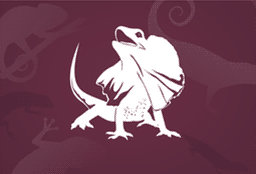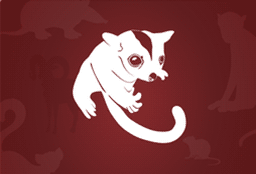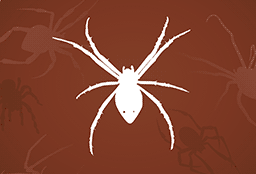A fawn to grey body with some mottling. It can change its colour from paler at night to darker during the day. Its tail can have a slightly flattened appearance and has small spines arranged in bands. It has bulging eyes with no eyelids.
Size
Body about 6 cm with tail 10 cm.
Black and white, with the pattern varying across its range. The back of its neck, upper tail and shoulders (on its wings) are white in males and grey in females, and (across most of Australia) the rest of its body is black. In south-eastern, central and south-western Australia, including Tasmania, its back and rump are entirely white. Its eye is red-brown. Young birds are usually grey rather than black and have dark eyes.
Distinctive feature
One toe faces backwards and three face forwards. It has a square-tipped tail.
Grey, grey-brown to olive green body with patches of cream. It has black bands running across its body and tail and a "crest" of spines which start on its head and extend down its back and along its tail. Its belly is creamy-white to creamy brown-grey and the larger, breeding males have a red-orange chest and throat. One of two subspecies also has a broad black stripe running from behind its eye to its ear. It has long, powerful legs and a long, strong tail with flattened sides to assist with swimming. There are loose folds of skin under its jaw.
Juveniles are light brown and their head and feet appear large for their body size.
Size
Around 80 - 90 cm long (nose to end of tail) two-thirds of which is tail. Males are bigger than females.
Almost completely black with a rusty-red or chocolate-brown patch at the back of its head and on its neck. Its fur can be tipped with grey, particularly on its belly. It has no fur on its lower legs.
Size
23 – 28 cm head and body length, wingspan over 1 m.
The Bush Stone-curlew has large yellow eyes and long thin legs. Its colouring is mostly grey-brown above, with bold black and rufous streaks. It has buff and white underparts with black streaks. Young birds are similar in colour, but are generally paler.
Distinctive feature
A prominent white eyebrow
Size
54 – 59 cm; wingspan is 82 – 105 cm
The caterpillar (larva) is initially pale yellow with fine hairs, before turning green. It has narrow yellow lines on its body which are sometimes hard to see. The upper side of the butterfly (adult) is white with a black tip on its forewing (front wing) and a black patch on the front edge of its hindwing. A male has one black spot on its forewing, while a female has two black spots. Looking from underneath, the forewing is white with two black spots and the hindwing is yellow.
Size
Caterpillar about 3.5 cm; Butterfly up to 5 cm wingspan.
The Channel-billed Cuckoo is grey all over, with dark scalloping on its back and wing-coverts, a whitish belly and abdomen, and fine dark barring on the lower underbody. Its long tail is pale-grey on top with two central feathers tipped with white, with a black band near the tip; the undertail has black-and-white barring. In flight, its tail and wings give it a cross-shaped silhouette. Its eyes are bright red and there is a bare patch of red skin around the eye and near the base of the bill. Its legs and feet are dark grey.
Young birds are mottled buff, brown and grey, have an olive to brown eye and lack the red-colouring around its eye.
Distinctive feature
Its large, downward-curved beak which is greyish with a paler tip.
The Christmas Spider is known by several other names, most commonly Jewel Spider but also as Six Spined Spider or Spiny Spider.
Females have bright yellow and white patterns with a ring of black spines. Melanic females have the same shape but may be completely black. Males have smaller spines and have a yellow, brown, white and black pattern. Six spines protrude from the sides and bottom end of the abdomen.
Size
Females are larger at 7 mm, males are 4 mm.
Its genus name Stenocarpus means narrow fruit, referring to its seed pods; and its species name sinuatus means wavy, referring to the edges of the leaves.
Evergreen tree, up to 35 m high, but much smaller when grown in gardens where it reaches a height of only about 10 m with a width of 5 m.
Leaves
Dark glossy green and paler underneath, they can be oval-shaped, lobed or have wavy edges. They are usually 15 – 25 cm long (but can be up to 45 cm long) and 2 – 5 cm wide, and are generally smaller on exposed branches. There is one distinct vein running down the centre of each leaf.
Flowers
Bright red with a yellow tip, and 2.5 – 4 cm long. They cluster in a wheel-like arrangement at the end of a stalk. The cluster can be up to 10 cm in diameter and consists of 6 - 20 flowers.
The female’s abdomen can be variable but is typically brown to yellow with short silvery-white hairs. The legs are usually black with bright yellow patches on the underside of the many leg joints. Its palps (small leg-like structures on either side of its fangs) are distinctly red.
It makes golden webs, after which it is named.
Size
Females are 4 – 4.5 cm long but the tiny males are only 5 – 6 mm long (body length). The Females can have a legspan of up to 15 cm!
Its head and upperparts are mostly dark grey, with a white eyebrow and throat, a narrow grey band across the upper breast and a creamy-buff belly. The feathers of its long tail have white edges and tips, and the tail is often fanned out.
Size
14 – 16 cm long
Dark grey to brown body, with lighter grey fur on its head and golden-orange fur encircling its neck. Its wings are black.
Distinctive feature
Fur on its legs that extends to its ankles.
Size
23 cm to 29 cm head and body length); wingspan over 1 m.
Deciduous tree, up to 35 m high, but much smaller when grown in gardens and in cooler areas where it reaches a height of only about 10 m. It can take 5 – 8 years to flower if grown from a seed.
Leaves
Smooth, oval-shaped and can have three or five lobes (and sometimes more). Each leaf is 10 – 30 cm long. The tree loses some or all of its leaves at the end of winter, before flowering, and the leaves turn yellow just before falling.
Flowers
Bright coral-red and bell-shaped, they occur in clusters at the end of branches. They are 1 – 2 cm long and have a waxy surface. They appear after the tree has lost all or some of its leaves.
Deciduous tree, not native to Australia. Grows up to 15 m high and wide.
Leaves
Bright green, feathery and fern-like. Individual leaves are narrow and elliptic, 3 – 12 mm long and arranged either side of a 5 – 10 cm long stem. They turn yellow in autumn before falling from the tree.
Flowers
Blue-purple and trumpet-shaped, forming clusters that are 20 – 30 cm in diameter. Each individual flower is 2 – 3 cm long and about 1 cm wide. They are lightly fragranced and remain on the tree for about 2 months.
There are four stamens inside the flower which produce pollen, and also a staminode which doesn’t produce any pollen.
A black and white bird, the pattern varies slightly between sexes. The male has a white eyebrow above a black horizontal eye-stripe, a black face and throat, while the female has a white face and throat, with a broad vertical stripe through the eye, and no white eyebrow. Both sexes have a thin white bill and black legs and feet. Juvenile Magpie-larks have a black forehead, white eyebrow and a white throat.
Black and white, with the pattern varying across its range. The back of its neck, upper tail and shoulders (on its wings) are white in males and grey in females, and (across most of Australia) the rest of its body is black. In south-eastern, central and south-western Australia, including Tasmania, its back and rump are entirely white. Its eye is red-brown. Young birds are usually grey rather than black and have dark eyes.
Distinctive feature
One toe faces backwards and three face forwards. It has a square-tipped tail.
Named in 1830 by explorer and botanist, Allan Cunningham. The genus name Grevillea honours Charles F Greville who co-founded the Royal Horticultural Society, and the species name robusta refers to its large size.
Evergreen tree usually grows 20 – 30 m tall but can range from 8 – 40 m in height.
Leaves
Silvery green and fern-like, green on the upper surface and paler underneath. They are 10 – 34 cm long and 9 – 15 cm wide, and consist of 11 – 31 segments that are narrow-elliptic to triangular in shape. The segments are 1.5 – 5 cm long and 2 – 10 mm wide, and they give the leaf a deeply divided appearance.
Flowers
Golden yellow to orange, each one is about 2 cm long but they are arranged in pairs along the flowering stalk to give an overall length of 12 – 15 cm.
Its genus name Banksia is named after Sir Joseph Banks, a British explorer and naturalist, and its species name marginata is from the Latin 'marginatus' meaning bordered, referring to the recurved leaf edges.
A variable species that occurs as a shrub, a flat-lying plant, or a tree, with smooth brown-grey bark. Grows up to 2 m high and wide as a shrub, less than 1 m as a flat-lying plant, and between 5 – 12 m as a tree.
Leaves
Green on the upper surface and silvery underneath. Each leaf is linear to oblong-shaped, 1 – 8 cm long, 3 – 13 mm wide, and has finely-toothed edges. The edges are recurved (rolled under) and may have small serrations, and their tip can be blunt or squared.
Flowers
Pale yellow cylindrical spikes forming a bottle-brush shape. Each flower head is 5 – 10 cm long and 4 – 6 cm wide and attracts nectar-eating birds.
Fruit/seed:
This spider is named for the cross the female weaves into the web. There are many theories about why the female does this including, strengthening the web, for camouflage, and for increasing prey catches as the cross reflects ultra-violet light which attracts insects. It may also deter predators which must go to the effort of cleaning off the extra silk after diving into the web.
The female has a silvery head with silver, yellow, red and black bands across its abdomen, and two yellow stripes running down its underside. Its legs are dark brown to black with one or two yellowish bands. The male and juveniles are brown and cream, with brown legs. It often appears to have only four legs because it sits with its legs in pairs along the stabilimentum.
Distinctive feature
The zigzag patterns (known as the stabilimentum) it weaves into its web to form an X or a cross, after which it is named.
Grey soft fur, with a white belly and a black stripe that runs from its nose, over its head and along its back. It has a long bushy tail, the last quarter of which is black, often with a white tip. Its ears are large and hairless, and its large eyes are black.
Size
About 28 cm long (from nose to tip of tail).
Metallic blue-black on top and light to dark grey on its breast and belly. Its forehead, throat and upper breast are rust in colour. It has grey legs and feet, and its eyes and bill are black. A young Welcome Swallow has shorter tail feathers than an adult and its forehead and throat are a creamy beige (instead of rust).
Distinctive feature
A deeply forked tail with a white band or row of spots on the long tail feathers.
It has dark brown to black fur with a bright white-stripe at the junction of the body and wings. Some individuals also have an area of white-fur on the chest.
One of the largest insectivorous (microbats) in Australia, it is in the ‘free tail’ family (Molossidae) which have a strong, stiff tail projecting beyond the tail membrane.
The species was formerly classified as Tadarida australis.
Size
85 - 100 mm head and body length; free tail extends 40 to 55 mm from the body. Adult average weight 37 g.
One of Australia's most widespread birds on mainland.Mostly black with a white belly and eyebrow. A young bird has paler, slightly rusty edges to its wing feathers.
Size
18 - 22 cm long (from head to tail)






